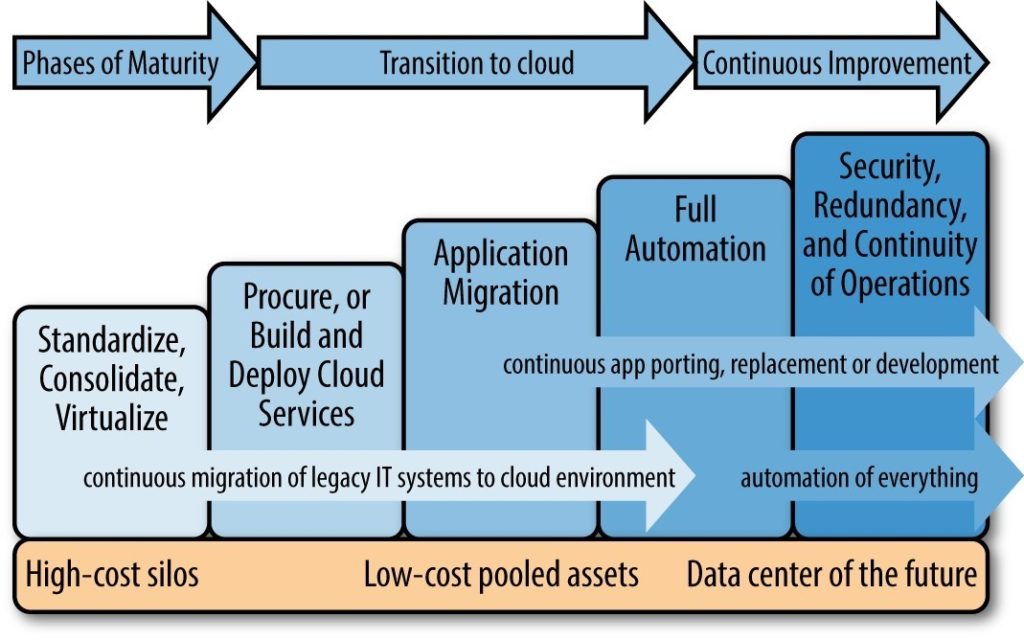Cloud Transition
Most successful organizations begin to use cloud services for rather simple applications or use cases and then steadily migrate more and more applications and data to the cloud over time. Organizations cannot adopt and move to the cloud instantaneously. Migrating applications and data to the cloud takes significant time and planning. Organizations can begin with the services easiest to migrate, such as public website hosting and email services, and then move on to databases, development and testing, multitier platforms, and custom enterprise application transformation.

Phases of the cloud transition
The transition to cloud-based services is represented in five phases, which are described in the following list (note that some of these phases are more applicable to the transition to an enterprise private cloud and less applicable to consumption of a public cloud service):
Phase 1: Standardized, consolidate, virtualize
To begin the transition, organizations often begin (even in their legacy datacenters) to standardize technologies and consolidate their server farms and datacenters—this is part of any datacenter modernization project, even if the cloud is not the end goal. This often includes implementing virtualization instead of physical servers as well as the implementation of centralized or virtualized storage using storage area networks (SANs) or similar storage systems. This phase is also where you should begin automating all existing server, OS, and applications using a combination of scripting and automated software installation tools (achieving full automation is phase 4).
Phase 2: Procure or build and deploy cloud services
A second phase of cloud deployment and transition is the deployment of a private cloud management platform, often within an existing enterprise datacenter. Building a private cloud requires careful planning, design, and implementation, so hiring an experienced cloud systems integrator is often the best way to ensure success. You might also begin procuring and using some public cloud services in this phase, such as one or more SaaS applications, Dev/Test services, or cloud storage.
Phase 3: Application migration
After the basic infrastructure and services of the cloud are deployed, you need to consolidate and modernize legacy applications. You can port some applications to a cloud service model rather easily, whereas some will require significant software development and transformation. Some large organizations have so many internal software products that this phase can take many years. At a minimum, you should target all new application development projects for cloud deployment while legacy applications are carefully evaluated on their return on investment (ROI) and feasibility for migration.
Phase 4: Full automation
Use the cloud management platform to configure automated ordering, approvals, provisioning, upgrades and patching, and monitoring. It is important to continuously evaluate and transform all legacy IT processes into automated ones. As much as possible, you should automate every process, from online ordering to provisioning of VMs and applications, to shorten deployment time, reduce personnel labor costs, and improve the accuracy and consistency of systems configuration. Although you should have begun basic automation in phase 1, this phase is where you bring the numerous individual scripts, application installers, and automation tools into an overall orchestration system in which you create service designs and workflows using the cloud management platform.
Phase 5: Security, redundancy, continuity of operations
You should evaluate legacy operational and security processes, because many will need to change before the cloud services are completed and online. Automated provisioning requires some pre-certification or blessing from IT security personnel of the VM templates, software-defined networks, storage mapping, OSs, and application platforms. This phase also includes building redundancy and resiliency, including the ability to continue operations of server farms, VMs, applications, and the cloud management platform in the event of localized or complete datacenter failure. Security operations and governance will be fully defined and matured in this phase—eventually transitioning to a fully operational state at the end of this five-phase cloud transition plan.